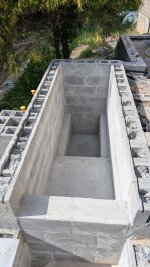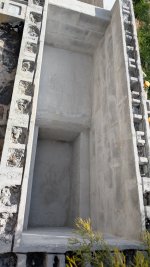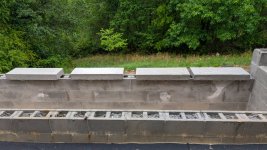Hi Garden Pond Forum!
This is my second thread and my first one helped me greatly as I am now well on my way to a completely DIY pond and bog. Thank you! Here, I'm sharing the early stage of my pond bog build and hoping for feedback as there is so much knowledge in the community that exceeds mine. Attached are photos of my concrete infrastructure. It's a 8' x 32" x 3' depth bog and a 4' x 2' x 2' depth settling chamber below that. The settling chamber will be isolated by 4 rebar reinforced concrete slabs that will sit on the shelves above the settling chamber. The bottom is pitched down to collect in the back of the settling chamber. The side shelves will support the concrete slabs which will support large river stones that transition to pea gravel for the upper fill. The gaps in the slabs will allow for space to pump water down into the settling chamber, have a cleanout pipe, and to allow water to go up through the supported rock. I'm hoping this complex design will achieve my goals of creating water filtration, large debris settlement, and easy cleanout. The overall pond volume is 2,100 gallons, and the 3000GPH pump will split it's flow to the bottom and top of bog. This is to keep bog flow slow enough for filtration and to provide an anti syphon effect when the pump is off. This weekend I will be installing 45mil epdm liner, the inflow pipe, and the slabs will be placed on the support shelves. Folding the liner into such a strange space is going to be a mess, full of folds, and I'm concerned about two things: 1) Maintaining a flat bottom to ensure easy backflow of materials down into the settling chamber during cleanout. 2) Keeping the liner from cracking when folds are placed under heavy force. Here's what I'm thinking:
Step 1: Put down epdm rubber squares on the bottom and on side shelves of bog as a flexible underlayment.
Step 2: Put down the main epdm liner and do my best with origami to minimize folds. The folds will not be visible but I do not want places with large force to be on top of excessive folding.
Step 3: Fill the bog with water to press the rubber into place.
Step 4: Drain water out of the bog.
Step 5: Smoother the shelves that will support the concrete slabs (separating the rock for the settlement chamber) with loctite PL roof and flashing goo.
Step 6: Smoother the sloped floor of the bog (now full of wrinkles) with loctite PL roof and flashing goo.
Step 7: Place cut pieces of epdm rubber on top of the loctite goo so as to create a flat surface and extra cushion.
Step 8: Install slabs, large river rock, medium river rock, and about 2.5' depth of pea gravel.
My hope here is that the layers of rubber/rubber/loctite PL roofing and flashing/rubber will provide a slightly flexible cushion preventing the weight of the slabs and stone on the creases from future cracks and leaks in the main rubber liner. It's complex but I'm optimistic. What do you think?
Thanks!
Andrew
This is my second thread and my first one helped me greatly as I am now well on my way to a completely DIY pond and bog. Thank you! Here, I'm sharing the early stage of my pond bog build and hoping for feedback as there is so much knowledge in the community that exceeds mine. Attached are photos of my concrete infrastructure. It's a 8' x 32" x 3' depth bog and a 4' x 2' x 2' depth settling chamber below that. The settling chamber will be isolated by 4 rebar reinforced concrete slabs that will sit on the shelves above the settling chamber. The bottom is pitched down to collect in the back of the settling chamber. The side shelves will support the concrete slabs which will support large river stones that transition to pea gravel for the upper fill. The gaps in the slabs will allow for space to pump water down into the settling chamber, have a cleanout pipe, and to allow water to go up through the supported rock. I'm hoping this complex design will achieve my goals of creating water filtration, large debris settlement, and easy cleanout. The overall pond volume is 2,100 gallons, and the 3000GPH pump will split it's flow to the bottom and top of bog. This is to keep bog flow slow enough for filtration and to provide an anti syphon effect when the pump is off. This weekend I will be installing 45mil epdm liner, the inflow pipe, and the slabs will be placed on the support shelves. Folding the liner into such a strange space is going to be a mess, full of folds, and I'm concerned about two things: 1) Maintaining a flat bottom to ensure easy backflow of materials down into the settling chamber during cleanout. 2) Keeping the liner from cracking when folds are placed under heavy force. Here's what I'm thinking:
Step 1: Put down epdm rubber squares on the bottom and on side shelves of bog as a flexible underlayment.
Step 2: Put down the main epdm liner and do my best with origami to minimize folds. The folds will not be visible but I do not want places with large force to be on top of excessive folding.
Step 3: Fill the bog with water to press the rubber into place.
Step 4: Drain water out of the bog.
Step 5: Smoother the shelves that will support the concrete slabs (separating the rock for the settlement chamber) with loctite PL roof and flashing goo.
Step 6: Smoother the sloped floor of the bog (now full of wrinkles) with loctite PL roof and flashing goo.
Step 7: Place cut pieces of epdm rubber on top of the loctite goo so as to create a flat surface and extra cushion.
Step 8: Install slabs, large river rock, medium river rock, and about 2.5' depth of pea gravel.
My hope here is that the layers of rubber/rubber/loctite PL roofing and flashing/rubber will provide a slightly flexible cushion preventing the weight of the slabs and stone on the creases from future cracks and leaks in the main rubber liner. It's complex but I'm optimistic. What do you think?
Thanks!
Andrew
Attachments
Last edited:




